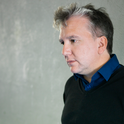In his 2010 book "Bloodlands: Europe Between Hitler and Stalin," the American historian Timothy Snyder identified an area stretching from central Poland, through Ukraine, Belarus and the Baltic States to western Russia in which some 14 million people were murdered by the Nazi and Soviet regimes between 1933 and 1945. Most of the victims were Jews, Belarusians, Ukrainians, Poles, Russians and Balts. This is the territory that Snyder calls the "bloodlands."
"Auschwitz," Snyder wrote in the introduction to that book, "is the most familiar killing site of the bloodlands." Today, he said, "it stands for the Holocaust." Yet most of the killing of Jews happened elsewhere—at the death factories of Treblinka, Chelmno, Sobibór and Belzec in Poland, and in the pits and ravines of Ukraine, Belarus, Lithuania and Latvia in which Jews were massacred tens of thousands at a time. In his new book, "Black Earth: The Holocaust as History and Warning," Snyder returns to this theme. In a chapter entitled "The Auschwitz Paradox," he writes: "While Auschwitz has been remembered, most of the Holocaust has been largely forgotten." "Black Earth" is an attempt to remember what, in Snyder's view at any rate, the mythography of the Holocaust leaves out.
To his recalibration of the conventional topography and chronology of the Holocaust, Snyder adds a novel interpretation of Hitler's worldview and of the place of Jews in it. For Hitler, Snyder argues, "the struggle against the Jews was ecological." Germans, Hitler thought, would never be able to feed themselves from their own land and territory. Fertile territory to the east had to be conquered, therefore. But the Jews encouraged the belief that scientific methods of land management would one day make Germany more fertile. "The world's problem, as Hitler saw it," Snyder writes, "was that Jews falsely separated science and politics and made delusive promises for progress and humanity. The solution he proposed was to expose Jews to the brutal reality that nature and society were one and the same." In the bloodlands, Hitler sought to create a state of nature. And so, in August 1941, the "Einsatzgruppen," mobile killing units that followed the conquering German armies into the Soviet Union, began to massacre Jews "in a setting they had themselves made anarchic."
Some readers have found this gloss on the Hitlerian worldview contentious. Reviewing "Black Earth" in the New Yorker, Adam Gopnik charges Snyder with downplaying the extent to which traditional forms of Christian anti-Semitism made the Holocaust possible. "We can't pretend," Gopnik argues, "that the Hitlerian crimes can be released from an anti-Semitism rooted in European Christianity." When I met Snyder in London last week, I began by asking him what he made of that charge.
TS: Anti-Semitism becomes a way in which one short-circuits an argument about why the Holocaust actually happened. If it were just anti-Semitism—for example, just popular anti-Semitism—then we’re left trying to understand why it happened then rather than at some other time. Hitler’s anti-Semitism was not just a more radical hatred of the Jews than other people had. His anti-Semitism was a way of making the whole world make sense. It was a response to globalisation. Hitler was saying that in a world of finite resources what really should be happening is that races should be competing for land and therefore for food; and that this is our natural condition, this is a law of nature. And if we’re not doing that, or if we’re prevented from doing that, it’s the fault of Jews.
JD: There are several very significant historiographical consequences that flow from that analysis of the Hitlerian worldview. One is your emphasis on what is known as the “Shoah by bullets,” the mass shootings of Jews in Soviet territory seized by the Germans in 1941, rather than the industrialised killing that took place at Auschwitz and other death factories in Poland. There you’re building on the analysis in Bloodlands aren't you?
In Bloodlands I was trying to be really modest about making big arguments. I was trying to set out in simple chronological and territorial terms what the killing policies actually were. My analytical claims there were largely negative. I was finding that the Holocaust was over-theorised, because [historians were] starting from premises which were empirically not the case. I’m trying now to answer my own question.
If you accept that, where does that lead you? My argument here is that what one sees is that as the Germans are moving from Austria, Czechoslovakia and Poland into the Soviet Union, as they are creating increasingly anarchic zones, they are able to experiment and to find ways in which a Final Solution can actually be carried out. You can only see that if you narrate the way they learned how to shoot Jews in ever larger numbers and more efficiently. If you start from an image of an industrialised Auschwitz—which is a false image, by the way—if you start from that image and then you link that to Hitler’s ideas, you’re drawing a short cut. Auschwitz doesn’t happen as a flowering of Hitler’s ideas. Auschwitz happens after a series of, as the Germans saw it, technical improvements. But the Holocaust begins with humans shooting humans at very short range.
Specifically, with Germans shooting Jews in Soviet territory. What room, then, does this analysis leave for the deportations of western European Jews to the east? Where do they fit in to the story you’re telling in this book?
The way you test the argument is by following the chronology after 1942 as the general policy of killing all Jews spreads to the west. The Germans learn it’s possible in the east. They then try to apply in the west and they run into various kinds of obstacles, all of them having to do with sovereignty. Each country is different, and the history of each country has to be narrated in its detail, but the basic pattern is that the more sovereignty there is the harder a time the Germans have in extracting Jews. So the intention is, and here I agree with everyone else, the intention is to murder all of the Jews everywhere there is German power. But from the German point of view, the problem is that German power is mediated by sovereignty—to an extent much greater than we would expect, the passport can actually stop the bullet. If you’re a Jew and you have citizenship in a country which the Germans recognise and that country doesn’t hand you over, then you’re going to survive.
Just to return to Gopnik's point about traditional anti-Semitism for a moment: how does Hitler's worldview, as you see it, in which all politics is a struggle for scarce resources, intersect with traditional forms of anti-Semitism?
There’s a kind of median between traditional between religious, anti-Judaic views and Hitler’s nature-rescuing, planetary anti-Semitism. The view that’s in the middle is the “Judeo-Bolshevik” idea. The idea that Jews are Bolsheviks and Bolsheviks are Jews. It plays a crucial role in Hitler’s work because it brings his planetary ideas, as it were, down to a particular part of the world. If Jews are communists and communists are Jews, that is, analytically, one example of how Jews are responsible for all ideas of reciprocity. But, practically, it means that the way the German race can get Lebensraum is to attack eastwards, because if the Soviet Union is just a Jewish state, then it’s going to fall apart as soon as you hit it. And also, since it’s a Jewish state, the moment you hit it you’re taking the first step against weakening Jewish domination. So the Judeo-Bolshevik idea is crucial because it provides a link between this almost celestial way of seeing things and a particular bit of territory, which is Ukraine.
And in places like Ukraine, Belarus and the Baltic states, you think it was that state failure that created the conditions in which the Einsatzgruppen, with the help of local populations, could go about their work. If you’re right, then the Soviet Union had already done the preparatory work in such places by undermining local political institutions.
There are a series of basic observations which I then seek to explain. The basic observations were in Bloodlands and the explanations are here. One of the observations is that the Holocaust starts precisely where Soviet and German power overlapped. Then the question is why, exactly, is that? And the answer that I provide here is political. The Final Solution could extend insofar as those states were destroyed, but it only became murder at this particularly dark point where Soviet state destruction was immediately followed by German destruction of Soviet institutions.
What exactly did Soviet state destruction mean? It meant the murder and deportation of elites, of people who had been responsible for politics. And the Soviet Union actually completely destroyed whole states—Estonia, Latvia, Lithuania go away—which creates, at least among some people, the desire to make those states come back. And once you have that desire, it becomes a resource that can be manipulated by the Germans.
So the Germans mobilise national sentiment in places like the Baltic States?
I hesitate to call it “national sentiment” because the way this discussion is often carried out is in terms of nationalism, but you don’t need to be a nationalist to be affected by the complete loss of sovereignty in our country. Another thing that happens is that when the Germans come, people have to get out from under this burden of having collaborated with the Soviets. And the Judeo-Bolshevik idea provides, in local politics, the way out. The collaborators who are not Jewish, which is the majority, can shunt the collaboration onto the Jews.
Is “collaboration” the right word to describe the involvement of local populations in the east?
That’s a very interesting question. “Collaboration” was a French political concept. It meant that you were making a deal, as one sovereign state, with another sovereign state. This deal makes sense for us thinking politically. The individuals who chose to go along with this or that German policy can’t be compared to whole states and the way they think about their interests is rather different. I do wish the vocabulary were a little bit richer. “Collaboration” in the French sense is an ideological position, whereas for people who collaborate, whether French individuals or eastern Europeans, there might be a politics to it, but not an ideology.
Let’s turn to the Polish chapter of the Holocaust. It has several distinctive features, as you point out. First of all, the gathering of Jews in ghettos. Then the use of the gas vans at Chelmno which led to technical refinements in the use of gas to murder Jews and the establishment of the death factories at Belzec, Sobibór and Treblinka. Why did the extermination camps appear in Poland and not in the Soviet Union?
It’s a really interesting question because it forces us to perform the elementary operation of chronology. When the Germans go into the Soviet Union they’re entering a zone, partly because of what the Soviets do and partly because of what [they themselves] do, where more possibilities are open than anywhere else. These possibilities are what lead to the fact of total killing and to the realisation that total killing is possible. Once you have that realisation, though, it doesn’t come with the associated techniques. The techniques in the Soviet Union led to the realisation. But once you have the realisation that doesn’t mean you have the tools to implement it everywhere. And so everywhere west of the Soviet Union, things looked a bit different.
In Poland, the Jews were in a particular situation that they were not in elsewhere—namely, they were already in ghettos. There, what’s possible, since these people are already gathered, is to deport them. But now deportation takes on a different meaning, because the Germans are never able to master Madagascar, the Siberian tundra or some other exotic location. What they are able to do is to create these death factories. The Jews are deported to death factories because that’s what’s possible. But notice that what they don’t do is go back to Poland and arm people. In the Soviet Union, when they have political resources that the Soviets have left behind, they do arm people. That’s not because Latvians are worse people than Poles, or Russians or Ukrainians are worse people than Poles. And it’s certainly not because they’re more anti-Semitic than Poles.
And then there is Auschwitz...
The Holocaust was much bigger than, and in some senses much worse than, Auschwitz. [Concentrating on] Auschwitz has the following problems: it draws our attention to the end of the Holocaust. Auschwitz becomes a major killing facility only in late 1943, early 1944—when most of the Holocaust is already done. The second problem with Auschwitz is that it has permitted an argument which, in different forms, [you find] in Hannah Arendt and [Raul] Hilberg: that you can kill people first by cataloguing them, separating them and concentrating them. Arendt, whom I much admire, has this terribly untrue sentence in Origins of Totalitarianism about how, once people are in concentration camps, it’s as if they’re already dead. In no sense is that true. It wasn’t in fact concentration that led to people’s deaths. Most of the people in concentration camps actually survived. And, in any event, they weren’t meant to die by being put in concentration camps. Auschwitz is confusing because it was first a concentration camp and then it also became a death facility. [But] it wasn’t purpose-built for killing Jews.
This is an edited transcript of a longer conversation. Timothy Snyder's "Black Earth: The Holocaust as History and Warning" is published by Bodley Head (£25)
"Auschwitz," Snyder wrote in the introduction to that book, "is the most familiar killing site of the bloodlands." Today, he said, "it stands for the Holocaust." Yet most of the killing of Jews happened elsewhere—at the death factories of Treblinka, Chelmno, Sobibór and Belzec in Poland, and in the pits and ravines of Ukraine, Belarus, Lithuania and Latvia in which Jews were massacred tens of thousands at a time. In his new book, "Black Earth: The Holocaust as History and Warning," Snyder returns to this theme. In a chapter entitled "The Auschwitz Paradox," he writes: "While Auschwitz has been remembered, most of the Holocaust has been largely forgotten." "Black Earth" is an attempt to remember what, in Snyder's view at any rate, the mythography of the Holocaust leaves out.
To his recalibration of the conventional topography and chronology of the Holocaust, Snyder adds a novel interpretation of Hitler's worldview and of the place of Jews in it. For Hitler, Snyder argues, "the struggle against the Jews was ecological." Germans, Hitler thought, would never be able to feed themselves from their own land and territory. Fertile territory to the east had to be conquered, therefore. But the Jews encouraged the belief that scientific methods of land management would one day make Germany more fertile. "The world's problem, as Hitler saw it," Snyder writes, "was that Jews falsely separated science and politics and made delusive promises for progress and humanity. The solution he proposed was to expose Jews to the brutal reality that nature and society were one and the same." In the bloodlands, Hitler sought to create a state of nature. And so, in August 1941, the "Einsatzgruppen," mobile killing units that followed the conquering German armies into the Soviet Union, began to massacre Jews "in a setting they had themselves made anarchic."
Some readers have found this gloss on the Hitlerian worldview contentious. Reviewing "Black Earth" in the New Yorker, Adam Gopnik charges Snyder with downplaying the extent to which traditional forms of Christian anti-Semitism made the Holocaust possible. "We can't pretend," Gopnik argues, "that the Hitlerian crimes can be released from an anti-Semitism rooted in European Christianity." When I met Snyder in London last week, I began by asking him what he made of that charge.
TS: Anti-Semitism becomes a way in which one short-circuits an argument about why the Holocaust actually happened. If it were just anti-Semitism—for example, just popular anti-Semitism—then we’re left trying to understand why it happened then rather than at some other time. Hitler’s anti-Semitism was not just a more radical hatred of the Jews than other people had. His anti-Semitism was a way of making the whole world make sense. It was a response to globalisation. Hitler was saying that in a world of finite resources what really should be happening is that races should be competing for land and therefore for food; and that this is our natural condition, this is a law of nature. And if we’re not doing that, or if we’re prevented from doing that, it’s the fault of Jews.
JD: There are several very significant historiographical consequences that flow from that analysis of the Hitlerian worldview. One is your emphasis on what is known as the “Shoah by bullets,” the mass shootings of Jews in Soviet territory seized by the Germans in 1941, rather than the industrialised killing that took place at Auschwitz and other death factories in Poland. There you’re building on the analysis in Bloodlands aren't you?
In Bloodlands I was trying to be really modest about making big arguments. I was trying to set out in simple chronological and territorial terms what the killing policies actually were. My analytical claims there were largely negative. I was finding that the Holocaust was over-theorised, because [historians were] starting from premises which were empirically not the case. I’m trying now to answer my own question.
If you accept that, where does that lead you? My argument here is that what one sees is that as the Germans are moving from Austria, Czechoslovakia and Poland into the Soviet Union, as they are creating increasingly anarchic zones, they are able to experiment and to find ways in which a Final Solution can actually be carried out. You can only see that if you narrate the way they learned how to shoot Jews in ever larger numbers and more efficiently. If you start from an image of an industrialised Auschwitz—which is a false image, by the way—if you start from that image and then you link that to Hitler’s ideas, you’re drawing a short cut. Auschwitz doesn’t happen as a flowering of Hitler’s ideas. Auschwitz happens after a series of, as the Germans saw it, technical improvements. But the Holocaust begins with humans shooting humans at very short range.
Specifically, with Germans shooting Jews in Soviet territory. What room, then, does this analysis leave for the deportations of western European Jews to the east? Where do they fit in to the story you’re telling in this book?
The way you test the argument is by following the chronology after 1942 as the general policy of killing all Jews spreads to the west. The Germans learn it’s possible in the east. They then try to apply in the west and they run into various kinds of obstacles, all of them having to do with sovereignty. Each country is different, and the history of each country has to be narrated in its detail, but the basic pattern is that the more sovereignty there is the harder a time the Germans have in extracting Jews. So the intention is, and here I agree with everyone else, the intention is to murder all of the Jews everywhere there is German power. But from the German point of view, the problem is that German power is mediated by sovereignty—to an extent much greater than we would expect, the passport can actually stop the bullet. If you’re a Jew and you have citizenship in a country which the Germans recognise and that country doesn’t hand you over, then you’re going to survive.
Just to return to Gopnik's point about traditional anti-Semitism for a moment: how does Hitler's worldview, as you see it, in which all politics is a struggle for scarce resources, intersect with traditional forms of anti-Semitism?
There’s a kind of median between traditional between religious, anti-Judaic views and Hitler’s nature-rescuing, planetary anti-Semitism. The view that’s in the middle is the “Judeo-Bolshevik” idea. The idea that Jews are Bolsheviks and Bolsheviks are Jews. It plays a crucial role in Hitler’s work because it brings his planetary ideas, as it were, down to a particular part of the world. If Jews are communists and communists are Jews, that is, analytically, one example of how Jews are responsible for all ideas of reciprocity. But, practically, it means that the way the German race can get Lebensraum is to attack eastwards, because if the Soviet Union is just a Jewish state, then it’s going to fall apart as soon as you hit it. And also, since it’s a Jewish state, the moment you hit it you’re taking the first step against weakening Jewish domination. So the Judeo-Bolshevik idea is crucial because it provides a link between this almost celestial way of seeing things and a particular bit of territory, which is Ukraine.
And in places like Ukraine, Belarus and the Baltic states, you think it was that state failure that created the conditions in which the Einsatzgruppen, with the help of local populations, could go about their work. If you’re right, then the Soviet Union had already done the preparatory work in such places by undermining local political institutions.
There are a series of basic observations which I then seek to explain. The basic observations were in Bloodlands and the explanations are here. One of the observations is that the Holocaust starts precisely where Soviet and German power overlapped. Then the question is why, exactly, is that? And the answer that I provide here is political. The Final Solution could extend insofar as those states were destroyed, but it only became murder at this particularly dark point where Soviet state destruction was immediately followed by German destruction of Soviet institutions.
What exactly did Soviet state destruction mean? It meant the murder and deportation of elites, of people who had been responsible for politics. And the Soviet Union actually completely destroyed whole states—Estonia, Latvia, Lithuania go away—which creates, at least among some people, the desire to make those states come back. And once you have that desire, it becomes a resource that can be manipulated by the Germans.
So the Germans mobilise national sentiment in places like the Baltic States?
I hesitate to call it “national sentiment” because the way this discussion is often carried out is in terms of nationalism, but you don’t need to be a nationalist to be affected by the complete loss of sovereignty in our country. Another thing that happens is that when the Germans come, people have to get out from under this burden of having collaborated with the Soviets. And the Judeo-Bolshevik idea provides, in local politics, the way out. The collaborators who are not Jewish, which is the majority, can shunt the collaboration onto the Jews.
Is “collaboration” the right word to describe the involvement of local populations in the east?
That’s a very interesting question. “Collaboration” was a French political concept. It meant that you were making a deal, as one sovereign state, with another sovereign state. This deal makes sense for us thinking politically. The individuals who chose to go along with this or that German policy can’t be compared to whole states and the way they think about their interests is rather different. I do wish the vocabulary were a little bit richer. “Collaboration” in the French sense is an ideological position, whereas for people who collaborate, whether French individuals or eastern Europeans, there might be a politics to it, but not an ideology.
Let’s turn to the Polish chapter of the Holocaust. It has several distinctive features, as you point out. First of all, the gathering of Jews in ghettos. Then the use of the gas vans at Chelmno which led to technical refinements in the use of gas to murder Jews and the establishment of the death factories at Belzec, Sobibór and Treblinka. Why did the extermination camps appear in Poland and not in the Soviet Union?
It’s a really interesting question because it forces us to perform the elementary operation of chronology. When the Germans go into the Soviet Union they’re entering a zone, partly because of what the Soviets do and partly because of what [they themselves] do, where more possibilities are open than anywhere else. These possibilities are what lead to the fact of total killing and to the realisation that total killing is possible. Once you have that realisation, though, it doesn’t come with the associated techniques. The techniques in the Soviet Union led to the realisation. But once you have the realisation that doesn’t mean you have the tools to implement it everywhere. And so everywhere west of the Soviet Union, things looked a bit different.
In Poland, the Jews were in a particular situation that they were not in elsewhere—namely, they were already in ghettos. There, what’s possible, since these people are already gathered, is to deport them. But now deportation takes on a different meaning, because the Germans are never able to master Madagascar, the Siberian tundra or some other exotic location. What they are able to do is to create these death factories. The Jews are deported to death factories because that’s what’s possible. But notice that what they don’t do is go back to Poland and arm people. In the Soviet Union, when they have political resources that the Soviets have left behind, they do arm people. That’s not because Latvians are worse people than Poles, or Russians or Ukrainians are worse people than Poles. And it’s certainly not because they’re more anti-Semitic than Poles.
And then there is Auschwitz...
The Holocaust was much bigger than, and in some senses much worse than, Auschwitz. [Concentrating on] Auschwitz has the following problems: it draws our attention to the end of the Holocaust. Auschwitz becomes a major killing facility only in late 1943, early 1944—when most of the Holocaust is already done. The second problem with Auschwitz is that it has permitted an argument which, in different forms, [you find] in Hannah Arendt and [Raul] Hilberg: that you can kill people first by cataloguing them, separating them and concentrating them. Arendt, whom I much admire, has this terribly untrue sentence in Origins of Totalitarianism about how, once people are in concentration camps, it’s as if they’re already dead. In no sense is that true. It wasn’t in fact concentration that led to people’s deaths. Most of the people in concentration camps actually survived. And, in any event, they weren’t meant to die by being put in concentration camps. Auschwitz is confusing because it was first a concentration camp and then it also became a death facility. [But] it wasn’t purpose-built for killing Jews.
This is an edited transcript of a longer conversation. Timothy Snyder's "Black Earth: The Holocaust as History and Warning" is published by Bodley Head (£25)












